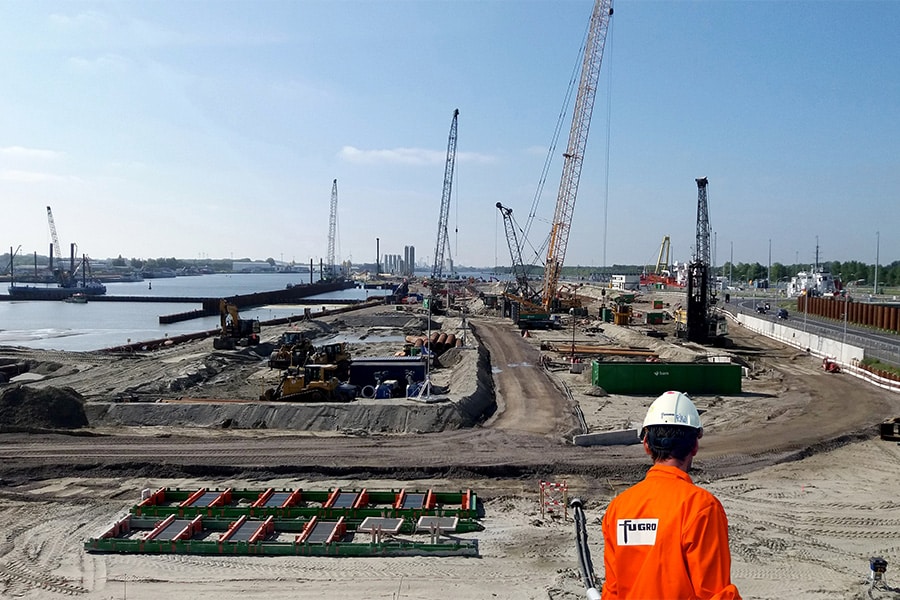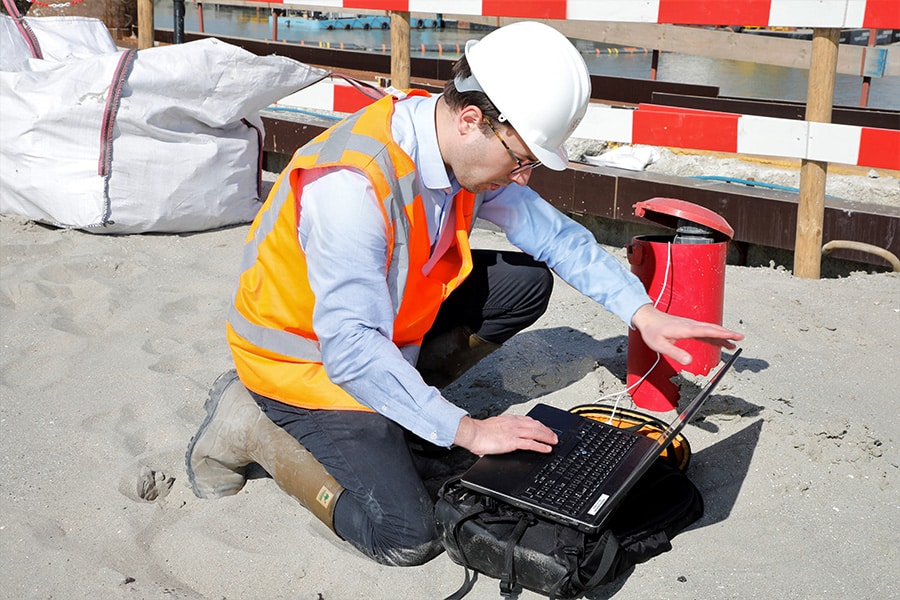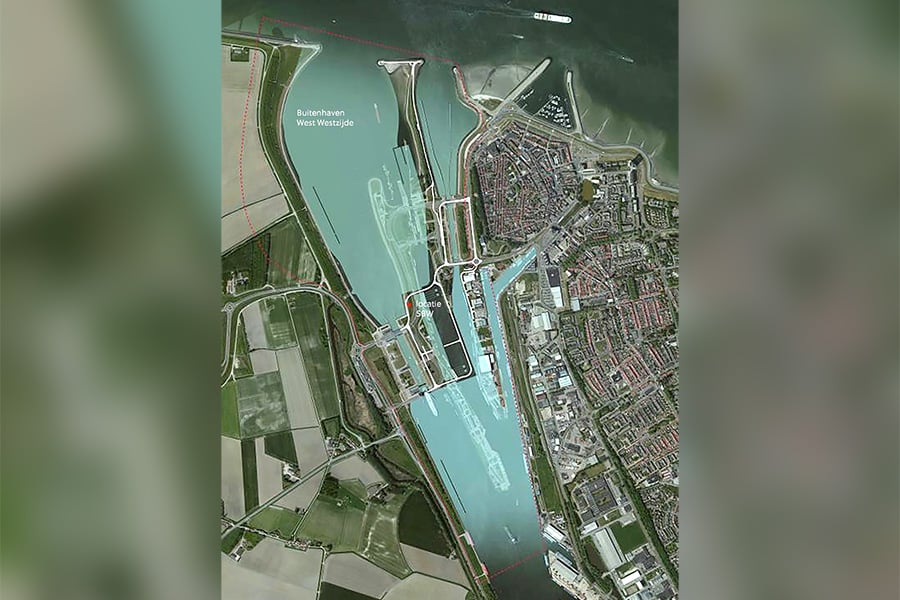
Measuring is knowing how to reduce nuisance
The construction of the New Terneuzen Lock was a mega-job and obviously did not go quietly. To build with as little inconvenience to local residents and adjacent land as possible, Fugro was already monitoring noise, vibrations and groundwater levels since 2018. But Fugro's role in the project went much further. In this article, we describe some highlights in ground investigation, consulting and monitoring from the Geo-data specialist.
"Back in 2017, Fugro was asked to assist in carrying out all kinds of monitoring work," begins Frank van der Kroon, senior project manager for monitoring at Fugro. "Creating a large construction pit involves large differences in water levels, as was also the case in Terneuzen for both lock heads. It is important to control these differences, which was done here by pumping (dewatering). If you don't, the tub collapses. Even steel sheet pile walls cannot withstand the enormous pressure of the water. On the other hand, if you pump out too much water, subsidence can occur which can lead to warping and cracks in houses. So pumping is necessary, but not too much, so that the water level stays within the set limits. And you can only check that by measuring it. Monitoring, in other words. Thus, at the beginning of the project we placed many dozens of monitoring wells."

All geo-data in one portal
Fugro started large-scale monitoring of water levels, among other things, in September 2018. "During the course of the project, our scope was increasingly expanded to include vibration and noise measurements in order to prevent damage to adjacent property, or adjacent sites, and to minimize noise pollution," Frank clarifies. "For example, in the preliminary phase we were involved in a trial of driving in tube piles and sheet piling, and we placed and measured prisms along the West Lock and at stable adjacent points to properly map the movement of the lock. In addition, we measured the water levels in the existing locks and in the Scheldt River and took pore pressure measurements in the subsurface. The latter is very important to measure, because too high a pore pressure can lead to softening of the ground, whereby instability -with major damage as a result- can occur. Moreover, the beauty of our service is that we present all monitoring data in one digital portal. That is truly unique."

Management and monitoring plan
Comprehensive management and monitoring plans underlie such a large-scale monitoring task, says Dave Wessling, geotechnical engineering consultant at Fugro. "It forms the link between design and realization.
The management plan clarifies all risks to the environment, plus the justification from the design as to why certain effects occur and how they are monitored and controlled. The monitoring plan describes for each object which measuring techniques are deployed and how to act and communicate when a limit value is exceeded."

Emergency phone
During the realization of the construction pits of the lock heads and lock chamber, regular monitoring meetings were held with contractor combination Sassevaart - consisting of BAM Infra, Stadsbader Contractors, DEME Infra Marine Contractors B.V. and Dredging International N.V., Van Laere N.V. and Equans - and with the client the Flemish-Dutch Scheldt Commission (VNSC). Here general findings were discussed, and any exceedances and measures taken were reviewed. During the period that groundwater monitoring was carried out, there was also a so-called 'alarm phone' that was active 24/7. Thanks to this system, possible deviations in groundwater levels were always noticed and controlled, even at times when no work was being done on the construction site. In November 2022, the construction pits were flooded. From then on, the periodic monitoring meetings ended and groundwater monitoring was no longer necessary. Measurements of vibrations and noise in Terneuzen will continue until the completion of the New Lock.
Settlement flow
Fugro was closely involved in the vibration test at Sluishhoofd Buiten Westzijde (SBW) in 2018, because of its far-reaching expertise regarding the management of subsidence risks. "The dike bodies at the New Lock are part of a primary flood defense system. As a result of vibrations caused by the installation of tubular piles and sheet piles, increased pore pressure can occur in a fine-grained sand layer. This decreases the effective grain stress, resulting in a decrease in the stability of a dike body as a whole. This can lead to settlement flashing, which can cause instability and cause the levee to fail," Dave explains. "During the trial, in which two tubular piles were installed both pile driving and vibratory, and another three sheet piles, the vibrations and pore pressures were measured up to sixty meters from the trial site. The measurement data allowed the forecast model (vibrations/water stresses in relation to stability) to be verified and/or adjusted. Further on at Buitenhaven Westzijde, similar problems were encountered. Also there, for the vibration tests to be carried out in 2020, we were involved in the plan design for the test, implementation of monitoring (vibration, pore pressure measurements and visual monitoring with perkoen piles), processing/interpretation of the measurement data and adjusting where necessary."

Combiconuses
The test concluded that the measured pore pressures were in line with the forecast, while the stability analyses showed that pore pressures and vibrations decrease the stability factor of a dike body by 20%, Dave explains. "Therefore, in order to control the stability during construction, drainage was applied. By reducing the pore pressures through pumping, the increased pore pressures due to the installation of the pipe piles/dam walls are compensated. During construction, extensive monitoring was used with pore pressure gauges, combi cones (cone that measures both vibrations and pore pressures at high frequency, ed.) and perkoen piles (deformation measurements) on the crest. There was also manned monitoring during installation so that it could be continuously checked whether the minimum required lowering of the water level was achieved, and whether the increase in pore pressures due to vibration remained below the set limits."
Natural deformation
Among other things, Fugro also prepared a settlement risk analysis for the adjacent existing West Lock. Dave: "This zoomed in on the geotechnical risks that could affect the Western Lock, such as a change in the groundwater level and the influence of bollard forces. After all, the West Lock remained in use as usual during the construction of the New Lock. All of these effects were understood. A large number of measuring points and vibration meters were also installed. The latter are useful the moment you start digging. What was striking, however, was that considerable deformation of the West Lock was measured even before construction of the New Lock had begun. In summer, the water in the lock chamber is warmer and that affects the concrete. It expands. So the lock is already naturally subjected to considerable deformation, an effect that was greater than originally expected. The degree of deformation even came close to the limit value originally set. So we were able to adjust it."
According to Frank, the temperature influence on the lock touches on an almost fundamental problem of monitoring. "Clients are often interested in the behavior of an object as a result of work elsewhere, but an object doesn't care about that. It reacts both to temperature and to work elsewhere. The trick is to determine what is due to what. A long baseline measurement is then crucial to draw good conclusions. With all our disciplines for ground research, consulting and monitoring, we were able to make an essential contribution to a successful implementation. It is precisely this integrality that distinguishes us in the market."
Heeft u vragen over dit artikel, project of product?
Neem dan rechtstreeks contact op met Fugro.
 Contact opnemen
Contact opnemen



